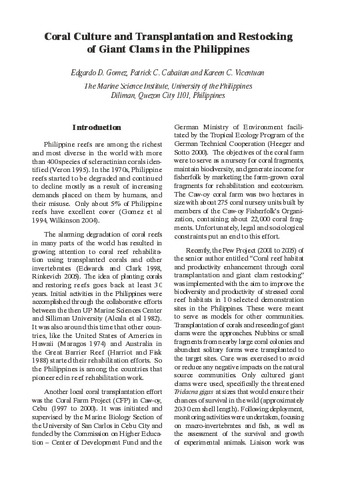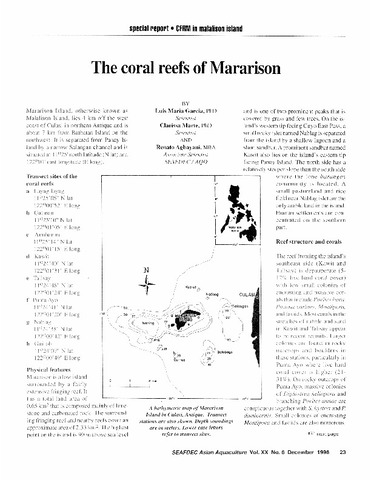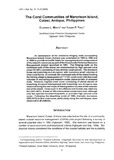| dc.contributor.author | Chan, Albert Apollo | |
| dc.contributor.author | Sukarno, W. | |
| dc.contributor.editor | Kawamura, Hajime | |
| dc.contributor.editor | Iwata, Tsuyoshi | |
| dc.contributor.editor | Theparoonrat, Yuttana | |
| dc.contributor.editor | Manajit, Nopporn | |
| dc.contributor.editor | Sulit, Virgilia T. | |
| dc.date.accessioned | 2018-11-17T14:57:36Z | |
| dc.date.available | 2018-11-17T14:57:36Z | |
| dc.date.issued | 2016 | |
| dc.identifier.citation | Chan, A. A., & Sukarno, W. (2016). Coral reef rehabilitation and restoration: Experience of Malaysia. In H. Kawamura, T. Iwata, Y. Theparoonrat, N. Manajit, & V. T. Sulit (Eds.), Consolidating the Strategies for Fishery Resources Enhancement in Southeast Asia. Proceedings of the Symposium on Strategy for Fisheries Resources Enhancement in the Southeast Asian Region, Pattaya, Thailand, 27-30 July 2015 (pp. 113-116). Samutprakan, Thailand: Training Department, Southeast Asian Fisheries Development Center. | en |
| dc.identifier.isbn | 9786163581600 | |
| dc.identifier.uri | http://hdl.handle.net/20.500.12067/703 | |
| dc.description.abstract | After the event of mass coral bleaching in 2010 and the ever vulnerability on the marine environment due to climate change, the Department of Marine Park Malaysia starts to look at ways to address the future of coral reefs through coral reef restoration. Approaches such as mitigation, adaptation and resilience need to be enhanced in Malaysia marine protected areas (MPAs). A coral restoration project was initiated in 2011 in collaboration with stakeholders such as Reef Check Malaysia. It takes about three years to reach maturity and two pilot sites had been established with encouraging result. The design of the coral frame structures goes through three different stages of which the present Cores 3 frame hopefully will enhance the spatial coverage for the project. The first two frame's design can hold about 24 coral fragments (nubbins) whereas the present Cores 3 can holds up to 70 coral fragments. A breakthrough of improved survival rates after the transplanted coral sources had been substitute using the 'coral of opportunity' as a 'seed' and increasing the size of each of the coral seed fragments to more than 10 cm length. Suitable site selection is an important factor in determining the success of the project. At the moment the genus from Acropora spp. and Pocillopora spp. are used for the coral transplant. | en |
| dc.language.iso | en | en |
| dc.publisher | Training Department, Southeast Asian Fisheries Development Center | en |
| dc.subject | South East Asia | en |
| dc.subject | Malaysia | en |
| dc.subject | Acropora | |
| dc.subject | Pocillopora | |
| dc.subject | bleaching | en |
| dc.title | Coral reef rehabilitation and restoration: Experience of Malaysia | en |
| dc.type | Conference paper | en |
| dc.citation.spage | 113 | |
| dc.citation.epage | 116 | |
| dc.subject.asfa | seed (aquaculture) | en |
| dc.subject.asfa | temperature effects | en |
| dc.subject.asfa | seeds | en |
| dc.subject.asfa | Adaptations | en |
| dc.subject.asfa | transplantation | en |
| dc.subject.asfa | resource conservation | en |
| dc.subject.asfa | Climatic changes | en |
| dc.subject.asfa | survival | en |
| dc.subject.asfa | fishery resources | en |
| dc.subject.asfa | restoration | en |
| dc.subject.asfa | artificial reefs | en |
| dc.subject.asfa | site selection | en |
| dc.subject.asfa | marine environment | en |
| dc.subject.asfa | coral reefs | en |
| dc.subject.asfa | nature conservation | en |
| dc.subject.asfa | marine parks | en |
| dc.subject.asfa | Coral | en |
| dc.subject.asfa | protected areas | en |
| dc.citation.conferenceTitle | Consolidating the Strategies for Fishery Resources Enhancement in Southeast Asia. Proceedings of the Symposium on Strategy for Fisheries Resources Enhancement in the Southeast Asian Region, Pattaya, Thailand, 27-30 July 2015 | en |



